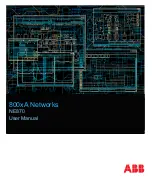
Platinum™ IP3
Installation and Operation Manual
Introduction
© 2016 Imagine Communications Corp.
Proprietary and Confidential.
September 2016 | Page 37
Alarms and LEDs
Status LEDs
on power supply units, resource cards, and various input/output modules are visible when
the door is open.
Alarms
on various modules are reported to the Platinum IP3 Controller to ease hardware management
of the system.
LED indicators reflect the status of sub-systems inside the frame. The indicators for each power supply
provide information on each voltage rail and the power supply’s fan. The indicators from each resource
module provide status information of the frame’s resource module. These indicators are lit green when
the system is functioning properly and red if a failure condition exists
For details on Alarms and LEDs, see:
Module LEDs (on page
Alarm Expansion Module (PX-ALARM) (on page 57)
Control Features
Your Platinum IP3 router makes use of the most innovative control systems available on the market
today. The operating system used for the Platinum IP3 router is a real-time embedded operating system
that uses an interrupt-driven and priority-based task scheduling algorithm to control the operations of
the Platinum IP3 router. This means that switches will occur in a timely manner, which allows the router
to be used in broadcast facilities where timing is crucial to the success of the facility.
The new Control System is the driving force behind the Platinum IP3 routing system. This new control
system breaks the traditional constraints of hard levels and fixed partitions, enabling unmatched
flexibility in grouping and routing signals according to signal attributes - a key need in complex
multichannel audio facilities and mixed HD/SD workflows.
Platinum IP3 Modules can be accessed and controlled via the web-based SDNO Controller.
For details, see the
SDNO Controller User Manual
integrated with the firmware.
PoE
The Platinum IP3 control network is designed to be a closed system. No other IP devices should be
placed on this network to avoid conflicts and excess traffic. Further, it has been found that PoE (power
over Ethernet) generating devices must not be used as these devices can cause damage to the PX-RES
module.
















































